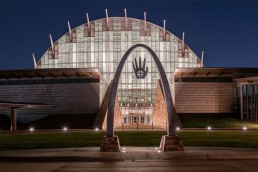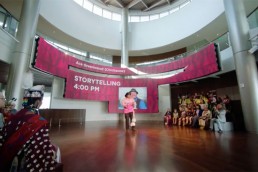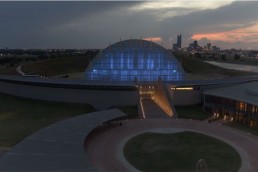This website uses cookies so that we can provide you with the best user experience possible. Cookie information is stored in your browser and performs functions such as recognising you when you return to our website and helping our team to understand which sections of the website you find most interesting and useful.
First Americans Museum
ProjectFirst Americans MuseumLocationOklahoma, United StatesDistributorPeerless AVLighting DesignerAbsenInstallerFord AVSubmitted byAbsen
The FAM serves as an educational and cultural hub in an industrial and low-income southeast side of Oklahoma City. The FAM will host programs and events for the community that will include a wide array of guided tours, music events, family friendly programs, festivals, hands-on workshops, seasonal activities, book signings, cooking demonstrations, lectures, seminars, and symposia.
The 200-seat FAM Theater can accommodate theatrical productions, film and video presentations, dances, and live music concerts, as well as lectures and seminars. The currently-in-development 5,000 square foot Family Discovery Center will provide a fun, educational place to take children—and admission is only $15 for adults; $10 for tribal citizens, senior citizens, veterans, and students; and $5 for youth ages 5-12.
There were two main ways that the stakeholders—namely, the 39 tribes of Oklahoma—were involved in the creation process. The first was the Oklahoma Legislature’s creation of the Native American Cultural and Educational Authority – a state agency created with the sole purpose of building this Museum. The second way was through the employment of Native Knowledge Givers. These Knowledge Givers were esteemed members of the tribes of Oklahoma who helped ensure that the FAM represented their tribe truthfully.
As far as environmental quality goes, although the FAM is only built on about 40 acres of the 213-acre site, all 213 acres given Environmental Site Assessments via EPA Region 6 and declared fit for reuse. It’s estimated that the FAM will host an average of 300,000 visitors per year, thereby bringing tourism and service industry users to the surrounding area.
Many Native American concepts of nature-based design are integrated into the Museum. The Museum is aligned with the cardinal directions, as First Americans have done for thousands of years. Special programming is planned for the winter and summer solstice, as well as the spring and autumnal equinox.
The Museum has an all-Native curatorial staff for many of their exhibits and programming, such as the inaugural OKLA HOMMA exhibition. OKLA HOMMA represents more than a decade of careful consultation with each of the 39 tribes, their Knowledge Givers and scholars. OKLA HOMMA shares the tribes’ diverse lifeways and experiences rather than presenting a singular, authoritative narrative. This Museum gives Native American tribes in Oklahoma a beautiful avenue in which to tell their stories, and their truths; and be represented not as people of the past, but how they are today along with the wonderful contributions they currently make to life and society.
In 2003, Applied Economics completed a study that estimated that the American Indian and Cultural Center would have a $2.6 billion total economic benefit for the Oklahoma economy within 20 years. The museum is anticipated to support over 2,500 jobs each year as a result of the increased tourism it will bring into the city. In addition, Oklahoma City could collect $4 million per year in new sales taxes once it opens. A share of sales taxes would flow to the state, as well.
FAM is committed to working with Indigenous vendors for food & beverage services. We seek opportunities to partner with tribes and Indigenous owned business. For example, we source buffalo meat from the Cheyenne & Arapaho Tribes of Oklahoma. We also seek to use Indigenous ingredients grown in Oklahoma.
In 2011, the Native American Cultural and Educational Authority (NACEA) enrolled 213 acres of land in the Oklahoma Corporation Commission (OCC) Brownfield Program. The OCC is Oklahoma’s state environmental agency with jurisdiction over oil and gas sites like this one. By partnering with the OCC, the NACEA hoped to receive regulatory oversight and an eventual Brownfield Program Certificate of No Further Action Necessary. While the OCC provided the necessary regulatory oversight, it was EPA Region 6 that provided the Environmental Site Assessments as Targeted Brownfields Assessments. EPA and NACEA divided the site into 4 priority areas to stagger the Environmental Site Assessments over a few years. Area I was assessed in August of 2011, Area II in December of 2011, Area III in June of 2012, and Area IV in September of 2014.
This tract of land nestled between the North Canadian River (now the Oklahoma River) and I-35 had long been notorious for being part of the historic Oklahoma City Oil Field. Phase I reports since 1994 have listed numerous industrial uses. The goals of the Phase II Environmental Site Assessments were to determine impacts to surface soil, subsurface soil, groundwater, and surface water from these recognized environmental conditions. The Phase II’s revealed low levels of contamination that were not considered a concern, based on risk-based screening levels. However, more than 7,000 tires and hundreds of old mattresses were removed from the site.
It is interesting to note that just south of this site across the railroad tracks, the USEPA initiated a cleanup at the Parawax Refinery; and included the United States Coast Guard (USCG), the OCC, and the Oklahoma Department of Environmental Quality (ODEQ). This remediation project was conducted for use of the site by the NACEA. All tanks, piping, holding ponds, oils, sludge, and buildings were removed; contaminated soil was excavated until tests were below detection limits; and the contaminated soil was removed to a local landfill.
Also, in 2003, Cardinal Engineering conducted a Preliminary Subsurface Exploration Report. In that investigation, over 200 environmental and geotechnical borings were completed–which identified additional areas of degraded crude oil contamination associated with reserve pit utilizations. At that time, representatives of the OCC inspected the Site and determined that covering the crude oil impacted areas with 4 to 6 feet of fill would mitigate the potential impacts.
And finally, between 2000 and 2011, the Oklahoma Corporation Commission plugged 7 wells using the State Well Plugging Fund (to the tune of $278,000); and the City of Oklahoma City plugged 6 wells, in preparation for site development.
On April 15, 2015, the OCC Brownfield Program issued a Certificate of No Further Action Necessary to NACEA. The Certificate included an institutional control: The groundwater at this property is restricted from use as a potable water or irrigation water source. The NACEA filed this Certificate with their property deed on November 6, 2015, at the Oklahoma County Clerk.
Gazing upon the shining exterior of the First Americans Museum today, you’d never guess that about 100 years ago, you’d be in the middle of the Oklahoma City Oil Field. You wouldn’t be able to walk 100 feet without stepping onto an oil-soaked well pad. At one point in the 1930s, an excess of 56 wells had been drilled on the 213-acre property. Phase I reports since 1994 have listed numerous abandoned oil/gas well sites, surface brine pits, sludge pits, aboveground storage tanks on site, a crude oil subsurface plume in the southern quadrant of the site, and an illegal tire dump. In addition, a spoil pile from the dredging of the Oklahoma River was also deposited on the north side of this site. When the EPA’s most recent environmental assessments began in 2011, the site still had one active oil/gas well, two non-producing oil/gas wells, a saltwater injection well, two tank batteries, and numerous oil/gas distribution high pressure transmission underground pipelines. Since its heyday as part of one of the most productive oilfields in the world, the site had sat abandoned—except for the eastern tip of the site, which spent a few years as a motocross track.



